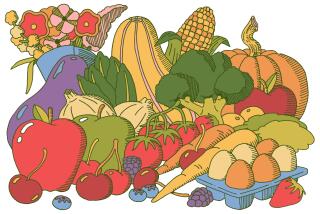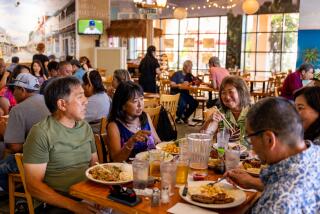Not All Hawaiian Crops Are Exotic
HONOLULU — As an agricultural state, Hawaii remains famous to mainlanders for its exported crops of sugar cane and pineapple. All but unknown, even to Islanders, are the crops grown by men like Henry Koja and Paul Otani and 681 other farmers, whose production tends more to the mundane than the exotic.
Koja and Otani are truck farmers. They and their colleagues produce a spectrum of vegetables almost exclusively for consumption within the state of Hawaii. The prime exception, according to the Hawaii Farm Bureau Federation, are Maui onions--sweet, yellow onions that grow on the mountain slopes of Maui and apparently enjoy a select following on the mainland.
“Frank Sinatra loves them,” claimed Hardy Hutchinson, a Farm Bureau spokesman here. “We can’t grow enough of them.”
Most commercial truck farming takes place on the slopes above the cane fields and pineapple groves, Koja and Otani said during a break in the annual meeting of the American Farm Bureau Federation, which drew 8,200 farmers and ranchers to Honolulu last week. Crops include broccoli, Chinese cabbage, celery, daikon, head lettuce and romaine, cucumbers, tomatoes, eggplant, green onions, watercress, sweet corn, watermelon, snap beans, green peppers and sweet potatoes.
“We can grow anything that is raised in California,” said Otani, who farms on Maui. Given Hawaii’s mountainous topography, he said, microclimates can be found to support just about any crop.
Most vegetable farmers grow from two to six different crops simultaneously, said Koja, who also farms on Maui. Their production winds up on local tables: Hawaiian truck farmers produce virtually all the cabbage, snap beans and green onions consumed in the Islands, and between half and three-quarters of all the romaine, cucumbers, tomatoes, head lettuce and celery. The proportion is increasing, as seen when the latest crop figures are compared to a recent five-year average, observed Aubrey Davis, head statistician for the state’s crop and livestock reporting service.
“One of the things we’ve been trying to do is to become more self-sufficient,” said Hardy Hutchinson, spokesman for the Hawaiian Farm Bureau Federation. “Every time the price goes up on the mainland, then our suppliers can compete.”
More frequently, however, competition from mainland produce hurts local growers, Hutchinson said. Mainland competition, not surprisingly, comes mainly from California, where growers are highly mechanized and grow two or three specialized crops on vast tracts, compared to Hawaii where truck farms are small, most of the labor is by hand and land is very expensive--costing from $20,000 to $50,000 an acre.
“It’s hard to compete because of the small scale,” Hutchinson said.
“Twenty acres is a large farm here,” Koja said. Truck farms range in size from two acres to several hundred, though about 10 acres are needed to support full-time farming in the Islands, he estimated.
Most farmers grow from two to six different commodities on their small spreads, taking advantage of the Islands’ year-round growing climate. “Mainland farmers ask me how many crops I raise a year, and I tell them I put lettuce seeds in the ground 52 weeks a year,” Koja said with a laugh. There’s another side to that, however, he added: “There is no dormancy period for pests.”
The small size of the Islands’ 683 truck farms inhibits the state’s efforts to increase self-sufficiency in produce. “It has been hard to maintain consistent quality and supply,” said Davis of the crop-reporting service. Recent efforts seek to increase market share by organizing the growers and securing their agreement to maintain specified levels of production. In addition, the University of Hawaii’s extension service is helping farmers choose their crops and improve marketing.
“I believe we’ll see a lot of improvement,” Davis said.
To the degree that that is accomplished, Koja said, it will be good for Hawaiian consumers, because when mainland crops fail, Island prices can go sky high. Lettuce imported from California has cost as much as $1.29 a pound, he recalled, while local growers can produce it for about 39 cents a head.
In the multiracial state, Japanese Hawaiians dominate the state’s farmers, followed by Filipinos and Caucasians, Davis said. Curiously, given the fact that to tourists poi, made from taro root, probably is as much associated with Hawaii as pineapples and sugar cane, Polynesians, the traditional taro growers, are not represented among the Islands’ truck farmers.
More to Read
Sign up for Essential California
The most important California stories and recommendations in your inbox every morning.
You may occasionally receive promotional content from the Los Angeles Times.










